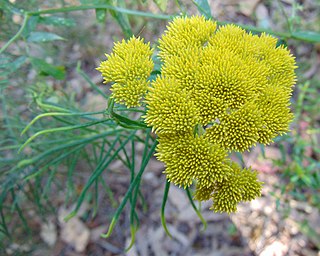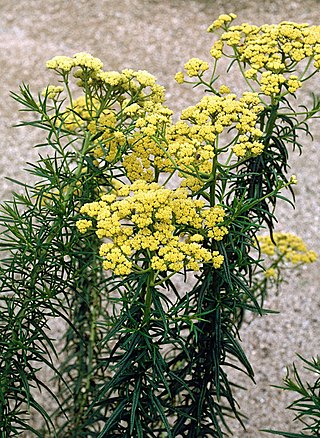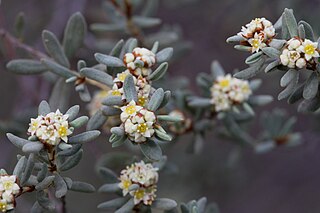
Homoranthus wilhelmii, commonly known as the eastern feather flower, is a species of flowering plant in the family Myrtaceae and is endemic to South Australia. It is a small, spreading shrub with cylindrical to flattened leaves and white or pink flowers arranged in corymbs on the ends of branchlets. The distribution includes an area on the Yorke Peninsula, but it is most common on the southern Eyre Peninsula.

Lasiopetalum behrii, commonly known as the pink velvet bush, is a species of flowering plant in the family Malvaceae and is endemic to southern continental Australia. It is an erect shrub with lance-shaped, narrowly oblong to narrowly elliptic leaves and groups of white to pink and reddish-brown flowers.

Cassinia tenuifolia, commonly known as bully bush or killmoke, is a species of flowering plant in the family Asteraceae and is endemic to Lord Howe Island. It is a dense, bushy shrub with hairy young stems, crowded linear leaves and sweetly scented flower heads arranged in corymbs.

Pultenaea densifolia, commonly known as dense-leaved bush-pea, is a species of flowering plant in the family Fabaceae and is endemic to southern continental Australia. It is a spreading or low-lying shrub with broadly egg-shaped, down-curved leaves and clusters of purple or yellow, red and purple flowers.

Cassinia compacta is a species of flowering plant in the family Asteraceae and is endemic to eastern Australia. It is a shrub with densely hairy stems, linear leaves and heads of yellow flowers arranged in dense corymbs.

Cassinia leptocephala is a species of flowering plant in the family Asteraceae and is endemic to New South Wales. It is a large, woody shrub with hairy, reddish stems, stiff linear leaves, and heads of pale yellow flowers arranged in a dense corymb.

Cassinia trinerva is a species of flowering plant in the family Asteraceae and is endemic to south-eastern Australia. It is an erect shrub or small tree with hairy stems, narrow lance-shaped leaves, and flower heads arranged in dense corymbs.

Cassinia longifolia, commonly known as shiny cassinia, is a species of flowering plant in the family Asteraceae and is endemic to eastern Australia. It is an erect, aromatic shrub with sticky, hairy foliage, linear or oblong to narrow lance-shaped leaves, and heads of creamy-white flowers arranged in a dense corymb.
Cassinia monticola commonly known as mountain cassinia, is a species of flowering plant in the family Asteraceae and is endemic to mountain areas of south-eastern Australia. It is a spreading shrub with sticky, narrow linear to narrow lance-shaped leaves, and bronze-coloured to greenish-cream heads of flowers arranged in a dense, round-topped corymb.

Cassinia venusta is a species of flowering plant in the family Asteraceae and is endemic to a small area near the border between New South Wales and Victoria. It is an erect shrub with glandular-hairy branchlets, glossy green, needle-shaped leaves, and corymbs of hundreds to thousands of yellowish flower heads.
Cassinia straminea is a species of flowering plant in the family Asteraceae and is endemic to eastern Australia. It is an erect shrub with hairy young stems, linear leaves and corymbs of up to several hundred flower heads.
Cassinia diminuta, commonly known as dwarf cassinia, is a species of flowering plant in the family Asteraceae and is endemic to Victoria in Australia. It is a small, erect, aromatic shrub with spreading, needle-shaped leaves that are covered with cottony hair on the underside, and corymbs of up to two hundred heads of flowers arranged in corymbs.
Pultenaea benthamii, commonly known as Bentham's bush-pea, is a species of flowering plant in the family Fabaceae and is endemic to south-eastern continental Australia. It is an erect shrub with sharply-pointed, narrow elliptic to linear leaves and yellow to orange and red flowers in clusters at the ends of branches.
Cassinia rugata, commonly known as wrinkled dollybush, or wrinkled cassinia, is a species of flowering plant in the family Asteraceae and is endemic to south-eastern Australia. It is a spreading to erect shrub with hairy, slightly sticky branchlets, oblong to narrow elliptic leaves and corymbs of up to three hundred flower heads.

Pultenaea canaliculata, commonly known as coast bush-pea, is a species of flowering plant in the family Fabaceae and is endemic to coastal areas of southern continental Australia. It is an rigid, spreading shrub with hairy, cylindrical leaves, and yellow and crimson flowers.
Cassinia tegulata commonly known as avenue cassinia, is a species of flowering plant in the family Asteraceae and is endemic to a small area near the Victoria-South Australia border. It is a small to medium-sized shrub with hairy foliage, needle-shaped leaves, and dense heads of off-white to cream-coloured flowers arranged in corymbs.

Cassinia wilsoniae is a species of flowering plant in the family Asteraceae and is endemic to a small area near the border between South Australia and Victoria. It is an erect shrub with densely hairy branchlets, needle-shaped leaves, and corymbs of twenty to fifty ochre-coloured flower heads.

Pultenaea subalpina, commonly known as rosy bush-pea, is a species of flowering plant in the family Fabaceae and is endemic to a restricted area of Victoria. It is a rigid, prostrate to erect or spreading shrub with linear leaves and pink, pea-like flowers.

Spyridium bifidum, commonly known as forked spyridium, is a species of flowering plant in the family Rhamnaceae and is endemic to South Australia. It is an erect shrub with densely softly-hairy young stems, wedge-shaped to linear leaves sometimes with a two-lobed tip, and densely woolly heads of white-velvety flowers.

Spyridium subochreatum is a species of flowering plant in the family Rhamnaceae and is endemic to southern continental Australia. It is a low shrub with linear to oblong or narrowly egg-shaped leaves, and dense clusters of creamy-white flowers with dark brown, papery bracts at the base.













